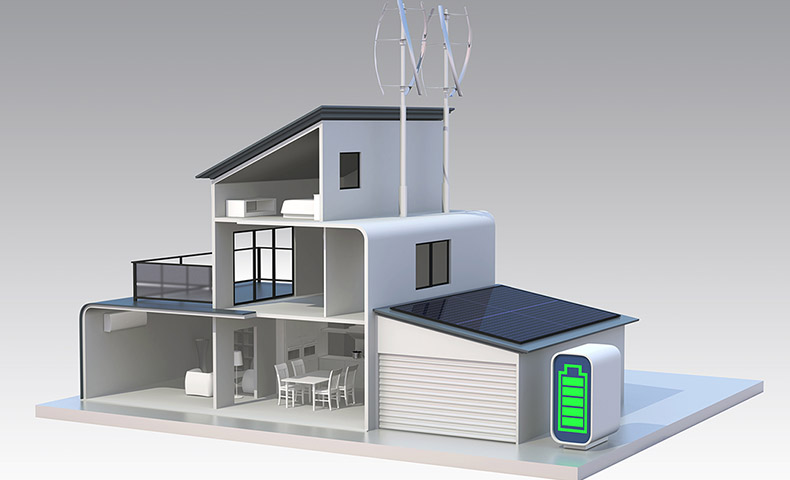
Summary:
While the installation of solar panels on your roof helps your pocket and the environment, having a battery to charge it with excess electricity before sending leftovers to the grid, may not be helping you much, as the energy return on investment for the entire system is 21 percent less than solar panels alone, a study by Stanford University found.
=======
Main Article:
The energy produced over the lifetime of typical rooftop solar panels more than makes up for the energy it takes to make, mount and then eventually recycle them. But adding a home battery usually lowers those dividends, according to new research from Stanford University.
Previous studies estimated the energy output to be about nine times the energy invested in solar panels. By contrast, a new study published by the Royal Society of Chemistry’s Sustainable Energy & Fuels examined the output from a typical rooftop system installed in five diverse American states. It found that the energy payout ratio ranges from a low of 14 in Alaska to a high of 27 in sunny Arizona – but only when homeowners are able to send surplus power to the grid.
However, when homeowners install a battery and charge it with excess electricity before sending leftovers to the grid, the energy return on investment for the entire system is 21 percent less than solar panels alone, researchers Simon Davidsson Kurland and Sally M. Benson found. When homeowners have no battery and no grid outlet, extra electricity is just wasted. Then, the system’s return on invested energy falls to seven in Alaska and a high of 14 in Florida – on par with earlier studies. Because homeowners in that scenario need to purchase electricity during the evening, adding a standard lithium-ion home battery improves the energy payback.
“The overall high returns show the energy benefits of photovoltaics across a wide range of U.S. geographical regions and, presumably, elsewhere,” said Benson, co-director of Stanford’s Precourt Institute for Energy and professor of energy resources engineering. “But they also demonstrate that if a state encourages homeowners to invest in rooftop systems to reach clean energy goals, then letting excess power flow to the grid makes the most of those investments.”
The much-studied metric “energy return on investment” helps assess policies that cannot be measured purely in economic terms, like achieving environmental goals. For now, photovoltaic panels are made using energy mostly from fossil fuels, so a 14- to 27-times payoff in renewable electricity buttresses policies that support solar power. As a counter example, the main argument against corn-based ethanol is that more energy goes into making and delivering it than ethanol produces in a car.
Financial payoffs for U.S. residential solar power, however, are unclear. Almost all states allow some selling of excess electricity to utilities, but how much homeowners get paid and how much they can sell varies. In most states, consumers get paid the same rate that they pay when they use the power. When the system is exporting to the grid, the customer’s meter goes in reverse. In a handful of states, though, homeowners get paid based on how much money their electricity in total saved the utility – a much lower price.
Adding batteries to a home photovoltaic system reduces the energy payback of the entire system by 21 percent on average due to two factors. First, adding batteries means more energy in the form of fossil fuels invested in making the entire system. Second, the amount of electricity a battery discharges is 8 percent less than the amount of electricity required to charge it – a loss compared to sending electricity directly to a larger electricity system with customers who can use the power immediately.
“As far as energy return on investment, it’s difficult to justify adding batteries to residential PV systems as long as excess generation can be made available for other users of the grid,” said Davidsson Kurland, who was a postdoctoral scholar at Stanford’s Global Climate & Energy Project when conducting this research. He is now a postdoctoral researcher at Chalmers University of Technology in Sweden.
There is hope for home batteries yet, Davidsson Kurland and Benson found. When selling to the grid is not an option, home batteries would hypothetically improve the return on the home system by 12 to 42 percent in the five states examined. The higher end of the range in the study is for a climate like Washington’s, where early afternoons can see a lot of sun but little residential electricity use, creating an opportunity for batteries. The lower end is for Florida’s climate, where heat and humidity drive air conditioning systems while the sun is shining even if nobody is home.
In reality, consumers can sell excess power back to the grid in Florida and – with limits – in Washington.


Input your address to see if it is solar friendly and how much you can save with solar.
Great. Your address is perfect for solar. Solar incentive is still available. Select monthly utility cost and calculate the size of solar system you will need now.
| kw System size | years Payback period | Lifetime savings |
No money down, 100% finance is available.

|
|
Check the price of solar panels in your area in a matter of seconds! |
Comments